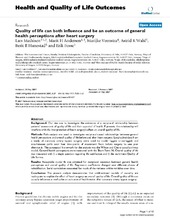Quality of life can both influence and be an outcome of general health perceptions after heart surgery
Mathisen, Lars; Andersen, Marit H.; Veenstra, Marijke; Wahl, Astrid K.; Hanestad, Berit R.; Fosse, Erik
Original version
https://doi.org/10.1186/1477-7525-5-27Abstract
Background: Our aim was to investigate the existence of a reciprocal relationship between patients' assessment of quality of life and their appraisal of health. If present, this relationship will interfere with the interpretation of heart surgery's effect on overall quality of life. Methods: Path analysis was used to investigate reciprocal causal relationships between general health perceptions and overall quality of life before and after heart surgery. Longitudinal data from a study of coronary artery bypass surgery were used to model lagged, cross-lagged, and simultaneous paths over four time-points of assessment from before surgery to one year afterwards. The conceptual framework for the analysis was the Wilson and Cleary causal pathway model. General health perceptions were measured with the Short Form 36. Overall quality of life was measured with i) a single question regarding life satisfaction and ii) the multi-item Quality of Life Survey. Results: Acceptable model fit was obtained for reciprocal causation between general health perceptions and overall quality of life. Regression coefficients changed over different phases of rehabilitation. Serial correlation accounted for much of the variance within variables over time. Conclusion: The present analysis demonstrates that unidirectional models of causality are inadequate to explain the effect of heart surgery on overall quality of life. Overall quality of life can causally influence as well as be an outcome of health status after coronary artery bypass surgery.
